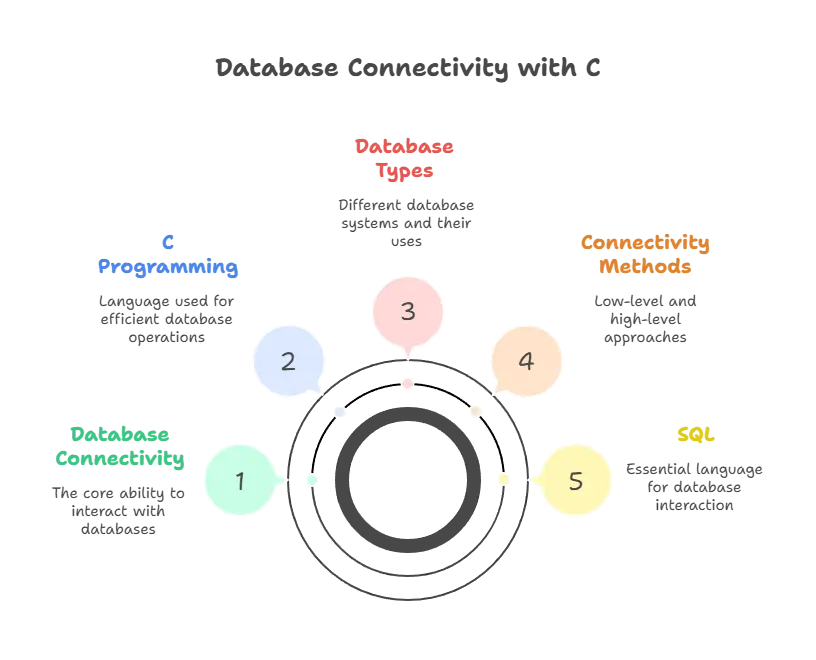Database Connectivity and operations
In this section, we'll introduce the concept of connecting databases with C programming language. We'll cover the basic concepts and terminologies to lay a strong foundation for understanding.
What is Database Connectivity?
Database connectivity refers to the ability of a program to interact with a database management system (DBMS) to perform various operations such as querying, updating, and managing data.
Why Database Connectivity with C?
C is a powerful programming language known for its efficiency and performance. Connecting databases with C enables developers to create robust and high-performance applications that can handle large volumes of data efficiently.
Types of Databases
There are various types of databases including relational databases (e.g., MySQL, PostgreSQL), NoSQL databases (e.g., MongoDB, Cassandra), and embedded databases (e.g., SQLite). Each type has its own advantages and use cases.
Preparing for Database Connectivity
Before diving into database connectivity with C, it’s essential to have a basic understanding of SQL (Structured Query Language) which is used to interact with databases. Additionally, you’ll need to install and set up a DBMS of your choice.
Low-Level Database Connectivity
Low-level database connectivity involves interacting directly with the database using native APIs provided by the DBMS. This approach offers fine-grained control but requires more effort.
#include <stdio.h>
#include <sqlite3.h>
int main() {
sqlite3 *db;
char *err_message = 0;
int rc = sqlite3_open("test.db", &db);
if (rc != SQLITE_OK) {
fprintf(stderr, "Cannot open database: %s\n", sqlite3_errmsg(db));
sqlite3_close(db);
return 1;
}
printf("Database opened successfully.\n");
sqlite3_close(db);
return 0;
}
// output //
Database opened successfully.
High-Level Database Connectivity
High-level database connectivity involves using third-party libraries or frameworks that provide abstraction over native database APIs, making it easier to work with databases.
#include <stdio.h>
#include <mysql/mysql.h>
int main() {
MYSQL *conn;
conn = mysql_init(NULL);
if (conn == NULL) {
fprintf(stderr, "Error initializing MySQL: %s\n", mysql_error(conn));
return 1;
}
if (mysql_real_connect(conn, "localhost", "user", "password", "database", 0, NULL, 0) == NULL) {
fprintf(stderr, "Error connecting to MySQL: %s\n", mysql_error(conn));
mysql_close(conn);
return 1;
}
printf("Connected to MySQL database successfully.\n");
mysql_close(conn);
return 0;
}
// output //
Connected to MySQL database successfully.

In this chapter, we've covered the fundamentals of database connectivity with C programming language. We started with an introduction to database connectivity, discussed the importance of using C for this purpose, and explored different approaches including low-level and high-level methods. We provided examples demonstrating how to connect to SQLite and MySQL databases. With this knowledge, you are now equipped to integrate database functionality into your C applications effectively. Happy coding!❤️
